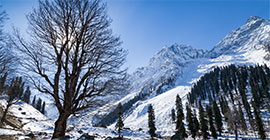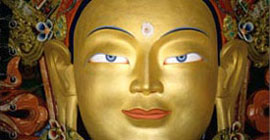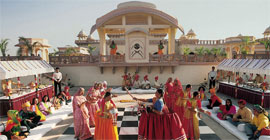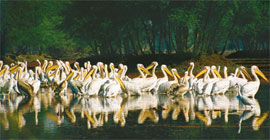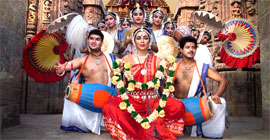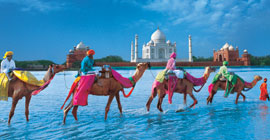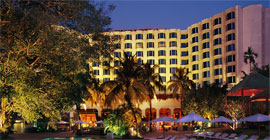NEW DELHI
Home | New Delhi
RED FORT
The Red Fort is a 17th century fort complex constructed by the Mughal emperor Shah jahan in the walled city of Old Delhi (in present day Delhi, India). It served as the capital of the Mughals until 1857, when Mughal emperor Bahadur Shah Zafar was exiled by the British Indian government. The British used it as a military camp until India was made independent in 1947. It is now a popular tourist site, as well as a powerful symbol of India's sovereignty: the Prime Minister of India raises the flag of India on the rampants of the Lahori Gate of the fort complex every year on Independence Day.
INDIA GATE
The India Gate is the national monument of India. It is one of the largest war memorials in India. Situated in the heart of New Delhi, India Gate was designed by Sir Edwin Lutyens. Originally known as All India War Memorial, it is a prominent landmark in Delhi and commemorates the 90,000 soldiers of the while British Indian Army who lost their lives fighting for the British Indian Empire, or more correctly the British Empire in India British Raj in World War I and the Afghan Wars.It is made up of red sand stone and granite.
QUTUB MINar
The Qutub Minar also spelled Qutab or Qutub, a tower in Delhi, India, is the world's tallest brick minaret. Construction commenced in 1193 under the orders of India's first Muslim ruler Qutb-ud-din Aibak, and the topmost storey of the minaret was completed in 1386 by Firuz Shah Tughluq. The Qutb Minar is notable for being one of the earliest and most prominent examples of Indo-Islamic architecture.
JANTAR MANTAR
Jantar Mantar is very popular among tourists and the people of Delhi. The structure is another great masterpiece of Indian architecture which shows the scientific acumen of ancient India. Jantar Manter is situated at Parliament Street, very close to Connaught Place. Jantar Mantar is also called Delhi Observatory. It is maintained by the Jaipur government because it was built by Maharaja Sawai Jai Singh II of Jaipur in 1710 A.D.The primary purpose of the observatory was to compile astronomical tables, and to predict the times and movements of the sun, moon and planets. Some of these purposes nowadays would be classified as astrology.
OLD FORT
Old Fort of Delhi is a fascinating building that survived the ravages of time. The Old Fort or the Purana Qila is also known as the 'Qila-i-kuhna masjid' built by Sher Shah Suri in 1541. Old Fort at Delhi is a perfect example of Lodi style of architecture in Delhi. The architecture of the Old Fort of Delhi is a fine blend of the Hindu elements together with the Muslim style of arches and domes. In short the style of architecture of the Old Fort can be considered as a secular architectural style.
CHANDNI CHOWK
Chandni Chowk, or 'Moonlight Square' is the most famous and historic street of Delhi, built around 300 years ago when the walled city of Shahjahanabad was established in the 17th century. The 'Trafalgar Square' of Delhi, Chandni Chowk Delhi is widely known for its century old heritage and meeting point of different cultures and traditions over the centuries. At present the street is a busy thoroughfare with its traditional framework of several 'Kuchas and Katras' (alleys) housing traditional Havelis, innumerable places of worship, popular specialized markets and century-old eating joints, known for their specialties not only in the capital but worldwide.
RASHTRAPATI BHAVAN
The Palace of Rashtrapati Bhavan is located in New Delhi. Until 1950 it was known as Viceroy's House and served as the residence of the Governor-General of India. On 12th December 1911, during the Delhi Durbar year it was announced by King George that the capital of India would be shifted from Calcutta to Delhi. As the plan for New Delhi took shape, the Governor-General's residence was given an enormous scale and prominent position. The British architect Edwin Landseer Lutyens, a key member of the city-planning process, was handed the prime architectural responsibility to design the building. The palace, comprising of more than 350 Rooms, was constructed to affirm the permanence of British rule in India. After Indian independence in 1947, the now ceremonial governor-general continued to live there, being succeeded by the Indian President in 1950 when India became a republic and the house was renamed Rashtrapati Bhavan.
BIRLA MANDIR
Birla Mandir, it is the first of the temples built across the country by the industrial family of Birla. Located just off Connaught Place on Mandir Marg, it is dedicated to Vishnu, the second of the Hindu Trinity of creator-preserver-destroyer, and his consort Lakshmi, the Goddess of wealth. Built in 1938, famous Birla Mandir in Delhi was inaugurated by Mahatma Gandhi (Father of the Indian Nation) on the express condition that people of all castes and especially untouchables would be allowed in. (Refer to section People). Consequently a plaque at the gate reiterates that people of all faiths and classes are welcome. Till date, it remains one of the most popular temples in Delhi.
SAFDARJUNG TOMB
Safdarjung's tomb was built by Nawab Shuja-ud-Daulah, the son of Safdarjung.Built in 1753-1754, the Safdarjung tomb lies at the Lodi road, New Delhi. Safdarjung's tomb is set in the middle of a garden, which spreads over an area of 300 sq m. The garden of Safdarjung's tomb is laid down on the pattern of the Mughal Charbagh style. The Safdarjung tomb was erected roughly on the pattern of Humayun's tomb.The tomb of Safdarjang was built to commemorate the memory of Wazir of Hindustan. It is situated in the center and has a huge dome. There are four water canals leading to four buildings. One of the canals has an ornately decorated gateway, while the other three are pavilions, with living quarters built into the walls. There are octagonal towers in the corners. There are also four oblong tanks (canals) on each side of the tomb.
AKSHARDHAM
The Akshardham Temple is one of the most recently built temples in Delhi. Constructed by the Bochasanvasi Aksharpurushottam Swaminarayan Sanstha (BAPS), it is situated on the banks of the River Yamuna. Delhi Akshar Dham Mandir was inaugurated in Novenmber'05 in the presence of President APJ Abdul Kalam. It is spread over an area of 100 acres and took about two years to complete. Akshardhaam Temple of New Delhi is built in an architectural style similar to that of the Akshardham temple of Gandhinagar in Gujarat, India. Its construction is based on the ancient Sthaapatya shastras of India and it is built without steel, entirely out of sandstone and marble.
DILLI HAAT
Dilli Haat, situated in the center of Delhi, is a kind of a weekly market, organized on a much grander scale. It is a permanent haat that offers an amalgamation of handicrafts, food and cultural activities. Dilli haat of Delhi, India is spread over an area of approximately 6 acres and has a typical traditional Indian village look to boast of. It is proud of its look that consists of a plaza paved with stone and brickwork and sprinkled with grass, flowering shrubs, eucalyptus trees, etc.
HUMAYUN'S TOMB
Humayun's Tomb was the first garden tomb made in India. The garden is divided into 36 squares by a grid of water channels and paths. The square garden is surrounded by a high rubble wall divided initially into four large squares separated by causeways and channels, each square divided again into smaller squares by pathways creating a char bagh. The laying down of the gardens in the Persian style was introduced by Babur and continued till the period of Shah Jahan. The entry to the Humayun's Tomb is through a long axial processional track. On the way, there are gateways, which offer a glimpse of the tomb. The tomb is octagonal in shape and placed over a platform with colonnades, under which there are numerous graves of lesser known people and can be ascribed to various nobles and workers of Humayun's period.The tomb is crowned by 42.5 m high colossal double dome.
BAHAI TEMPLE
In the heart of New Delhi, the bustling capital of India, a lotus-shaped outline has etched itself on the consciousness of the city's inhabitants, capturing their imagination, fuelling their curiosity, and revolutionising the concept of worship, this is the Bahá'í Mashriqu'l-Adhkar, better known as the "Lotus Temple". With the dawning of every new day, an ever-rising tide of visitors surges to its doorsteps to savour its beauty and bask in its serenely spiritual atmosphere.It is a very recent architectural marvel of the Bahai faith, located in Kalkaji, south of Delhi. Shaped like a half opened Lotus flower, this temple is made of marble, cement, dolomite and sand. It is open to all faiths and is an ideal place for Bahai Temple, New Delhimeditation and obtaining peace and tranquility.
LODI'S TOMB
Lodi Tomb is situated amidst the famous Lodi Garden, adjoining the Indian International Centre in South Delhi. It is one of the many mausoleums in the city that have been built inside a garden. Lodi Tomb entombs Sikandar Lodi. The other mausoleums situated inside the Lodi Gardens, along with the Lodhi tomb, include the Tomb of Muhammad Shah, Shish Gumbad and Bara Gumbad. It is said that all these tombs are the snippets of another city, which was supposed to be built at this place.The tomb of Sikandar Lodi is an octagonal tomb that is known for its beautiful Mughal architecture. It said to have signified the resumption of the Sayyid type architectural style, with the typical octagonal plan, deep veranda and tall arches. The tomb has been adorned with a double dome top are stands proudly at the center of an enclosed area, which is entered from a south-facing huge gateway. The first garden tomb to be constructed in the capital city of India, Lodi Tomb dates back to the early 16th century.
MUSEUMS
Museums in Delhi, the capital city of India, are a showcase of the past and the present. Art lovers would certainly love the splendid display of contemporary art in the National Gallery of Modern Art at Jaipur House. One can also have a glimpse over the relics and artifacts of ancient India, ranging from the times of Indus Valley Civilization to the present, at the National Museum. The open air Crafts Museum is the best place to witness Indian craftsmen at work.The museums of Delhi will fascinate any visitor who is curious to know what the heritage of Delhi is all about.The museum also has activity rooms for children to play and learn.The major museums of New Delhi are- Crafts Museum,Indira Gandhi Memorial Museum,National Museum,National Museum Of Natural History,National Rail Museum,National Science Centre Museum,Nehru Museum and Planetarium,Sangeet Natak Akademi,Sanskriti Museum,Shankar's International Dolls Museum,National Gallery Of Modern Art, Tibet House Museum.







